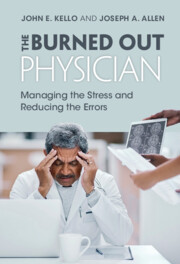Book contents
- The Burned Out Physician
- The Burned Out Physician
- Copyright page
- Dedication
- Contents
- Figures and Tables
- Preface
- Acknowledgments
- Chapter 1 The Psychology of Burnout
- Chapter 2 The Burned-Out Physician
- Chapter 3 Types of Medical Error
- Chapter 4 Sources of Medical Error
- Chapter 5 How-To Strategies for Addressing the Crisis
- Chapter 6 Solution #2: Engage in Self-Care
- Chapter 7 Solution #3: Seek Social Support
- Chapter 8 Solution #4: Follow the Advice You Would Give Patients
- Chapter 9 Solution #5: Perform Effective Team Leadership
- Chapter 10 Solution #6: Ensure Collaborating Team Members
- Chapter 11 Solution #7: Establish and Sustain a Positive Team Culture
- Chapter 12 Solution #8: Make Changes in Workflow in Organizations
- Chapter 13 Solution #9: Make Changes in Management Practices in Local Healthcare System Top Leaders
- Chapter 14 Solution #10: Make Changes in Overall Healthcare System Processes
- Chapter 15 Solution #11: Make Changes in National Healthcare
- Chapter 16 Saving the Burned-Out Physician
- Index
- References
Chapter 1 - The Psychology of Burnout
Published online by Cambridge University Press: 08 July 2022
- The Burned Out Physician
- The Burned Out Physician
- Copyright page
- Dedication
- Contents
- Figures and Tables
- Preface
- Acknowledgments
- Chapter 1 The Psychology of Burnout
- Chapter 2 The Burned-Out Physician
- Chapter 3 Types of Medical Error
- Chapter 4 Sources of Medical Error
- Chapter 5 How-To Strategies for Addressing the Crisis
- Chapter 6 Solution #2: Engage in Self-Care
- Chapter 7 Solution #3: Seek Social Support
- Chapter 8 Solution #4: Follow the Advice You Would Give Patients
- Chapter 9 Solution #5: Perform Effective Team Leadership
- Chapter 10 Solution #6: Ensure Collaborating Team Members
- Chapter 11 Solution #7: Establish and Sustain a Positive Team Culture
- Chapter 12 Solution #8: Make Changes in Workflow in Organizations
- Chapter 13 Solution #9: Make Changes in Management Practices in Local Healthcare System Top Leaders
- Chapter 14 Solution #10: Make Changes in Overall Healthcare System Processes
- Chapter 15 Solution #11: Make Changes in National Healthcare
- Chapter 16 Saving the Burned-Out Physician
- Index
- References
Summary
Burnout is a specific work-related syndrome resulting from chronic workplace stress that has not been successfully managed. Sufferers experience physical and mental exhaustion, cynicism and a sense of depersonalization, and reduced feelings of efficacy; these are the defining facets of burnout. The syndrome shows itself in a variety of dysfunctional emotions, thought processes, and behaviors. The primary culprit is stress. While the “natural” response to a stressor (the fight-or-flight reaction) is adaptive in the short term, prolonged activation of that response can eventually result in burnout. Research over the last several decades has highlighted the risk for physicians and other healthcare providers, and recent studies have shown that the risk has been dramatically enhanced during the coronavirus pandemic. This book will explore the syndrome in detail, the specific risks that healthcare providers incur, and the relation between burnout and medical error. As our ultimate goal is to provide support for those healthcare workers and those affected by their work, we explore a range of critical approaches to reducing burnout (our proposed evidence-based “solutions”).
- Type
- Chapter
- Information
- The Burned Out PhysicianManaging the Stress and Reducing the Errors, pp. 1 - 27Publisher: Cambridge University PressPrint publication year: 2022



